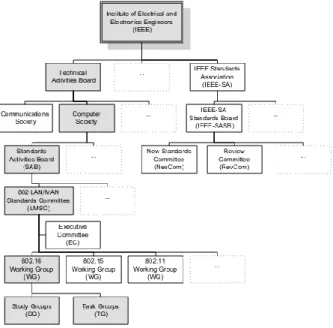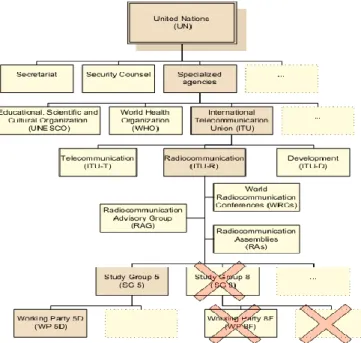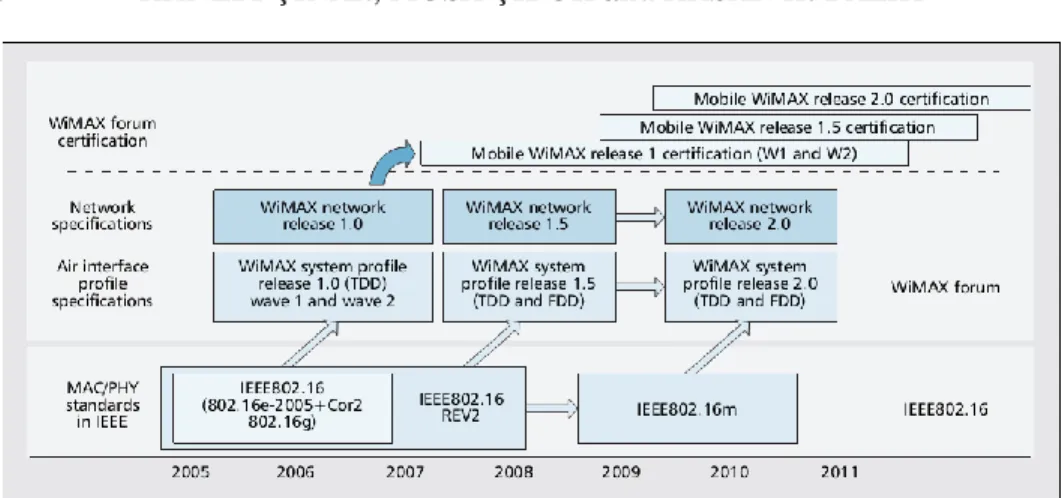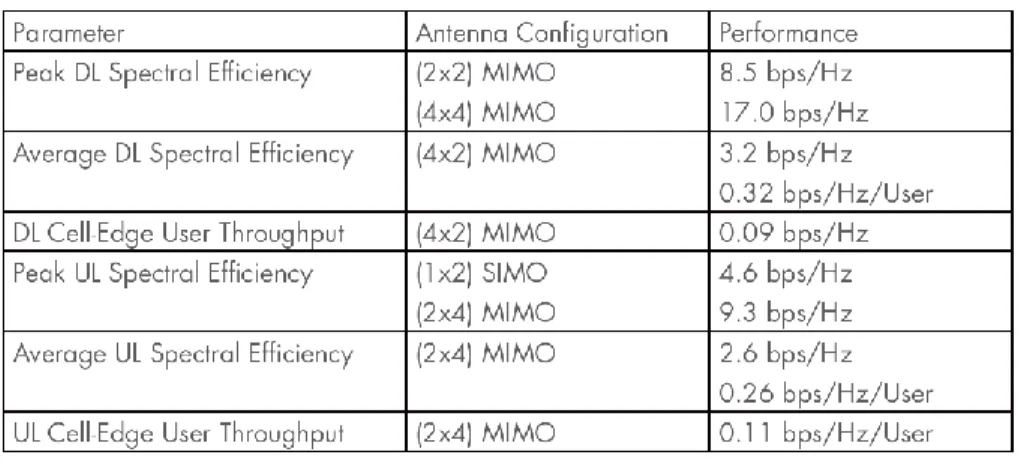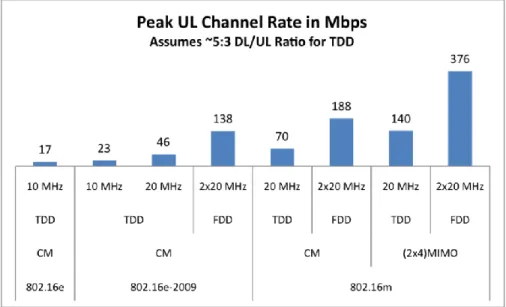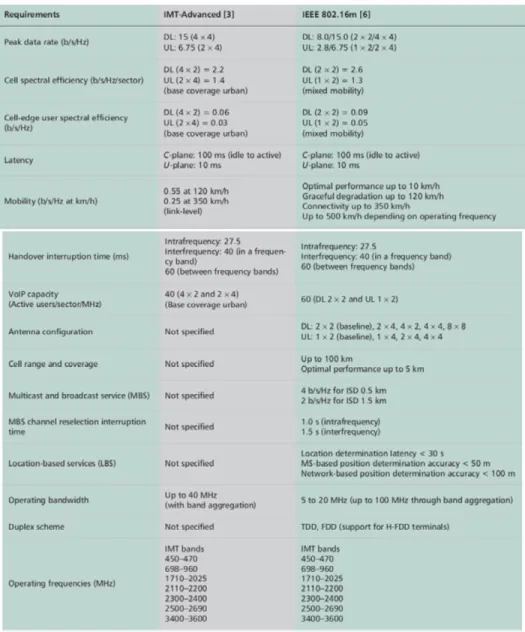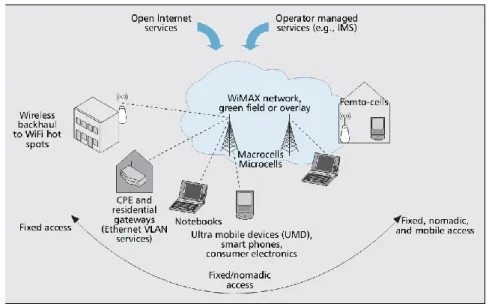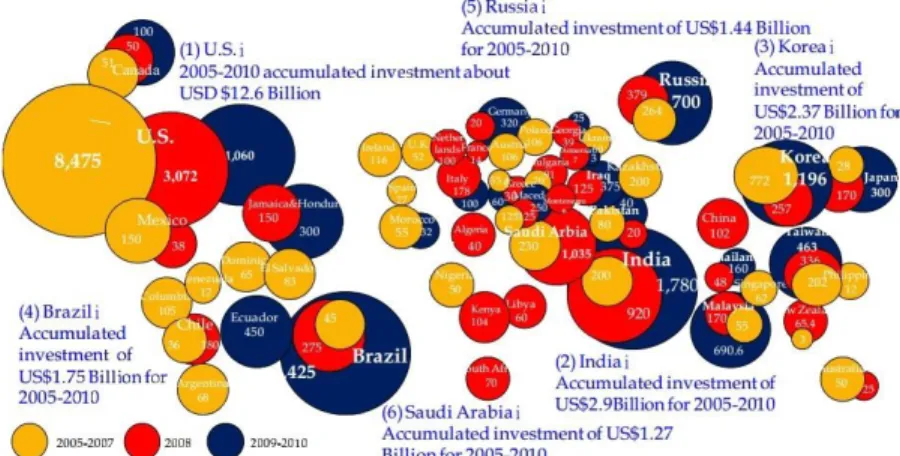© 2012 Mili Publications
:
Keywords wimax, mobile wimax, IEEE 802.16e, IEEE 802.16m, 2000, IMT-advanced.
HISTORY AND EVALUATION OF MOBILE WIMAX
HANEFI ÇINAR1, MUSA ÇIBUK2 and HASAN H. BALIK3
Bitlis Eren University1,2
Turkey
Istanbul Arel University3
Istanbul, Turkey
E-mails: hcinar@beu.edu.tr1 mcibuk@beu.edu.tr hasanbalik@gmail.com
Abstract
The growing demand for mobile Internet and wireless multimedia applications has motivated the development of broadband wireless access technologies in recent years [1]. Mobile WiMAX was the first mobile broadband wireless access solution based on the IEEE 802.16e-2005 standard [2].
The paper reports on history of WiMAX and mobile WiMAX evaluation. There are three key themes examined on this report. These are Mobile WiMAX and Its Historical development, Mobile WiMAX Evaluation, and Advantages of Mobile WiMAX.
Introduction
The growing demand for mobile Internet and wireless multimedia applications has motivated the development of broadband wireless access technologies in recent years [1]. IEEE 802.16, a solution to broadband wireless access (BWA) commonly known as Worldwide Interoperability for Microwave Access (WiMAX), is a recent wireless broadband standard that has promised high bandwidth over long-range transmission [3]. WiMAX is a wireless communications standard designed to provide 30 to 40
megabit-per-Applied Mathematical and Computational Sciences, Volume …, Issue …, 2012
second data rates, with the 2011 update providing up to 1 Gbit/s for fixed stations. It is a part of a “fourth generation” or 4G, of wireless-communication technology [4, 5].
Mobile WiMAX was the first mobile broadband wireless access solution based on the IEEE 802.16e-2005 standard [2]. Mobile WiMAX was successfully adopted by ITU as one of the IMT-2000 technologies inNovember 2007. Since then mobile WiMAX(a.k.a. IP-OFDMA) has officially become amajor global cellular wireless standard alongwith 3GPP UMTS/HSPA and 3GPP2 CDMA/EVDO. Mobile WiMAX is an OFDM-basedtechnology available for deployment today[6, 7], and new WiMAX devices come to market at muchreduced cost than that of current 3G solutions.In December 2006 the IEEE launched an effort to further evolve the IEEE 802.16 WirelessMAN-OFDMA specification. This amendment, known as 802.16m, is designed to meet or exceed the requirements of IMT-Advanced (the 4th generation of cellular systems) [8].
In October 2008 over 260 service providers deployed fixed, portable and mobile WiMAX networks in 110 countries [9]. WiMAX Forum was announced that WiMAX Service Providers offer 430 million people or points-of-presence (POPs) globally in 2009 and were on a path to nearly double to 800 million people by the end of 2010 [10]. Furthermore over 11000 deployments made by providers during March 2009 - May 2011 [11].
In our study we have researched history of WiMAX and given detailed informationin Section II.IMT (International Mobile Telecommunications) standards and Mobile WiMAX evolution are evaluated and reviewed in Section III. Furthermore someopinions about advantages of Mobile WiMAX are given in Section IV. Finally conclusions are drawn in Section V.
2. History Of Mobile WiMAX
IEEE 802.16, a solution to broadband wireless access (BWA) commonly known as Worldwide Interoperability for Microwave Access (WiMAX), is a recent wireless broadband standard that has promised high bandwidth over long-range transmission [3]. This glaring technology evolution has started on
November 98, and all WiMAX and Mobile WiMAX technologies are successfully adopted by ITU as one of the IMT-2000 or IMT-Advanced technologies.
IEEE 802.16 Work Group develops standards and recommended practices to support the development and deployment of Broadband Wireless Metropolitan Area Networks (Wireless-MAN). IEEE (Institute of Electrical and Electronics Engineers) is an international professional organization about engineering on areas including aerospace systems, computers, telecommunications, biomedical engineering, etc. [12]. It has over 395000 members in more than 160 countries by 2010 [13]. It has more than 2 million documents in the IEEE/IET electronic library and sponsors more than 300 conferences annually. IEEE organized in the 38 societies and 7 technical councils.
Within the IEEE Computer Society [14], the IEEE-802 LAN/MAN Standards Committee (LMSC) [15] is one of the multiple standards committees of the Standard Activity Board (SAB). The LMSC develops Local Area Network (LAN) and Metropolitan Area Network (MAN) standards [16], mainly for the lowest 2 layers of the ISO (International Organization for Standardization) Reference Model for Open Systems Interconnection (OSI) [17].
Within the LMSC, there are a number of Working Groups (WGs) and one Executive Committee (EC), which includes amongst others all WG chairs. One of the LMSC Working Groups is the IEEE 802.16 Working Group of Broadband Wireless Access Standards. The Working Group has completed different standards projects since 2001 [18].A simplified hierarchical view on the IEEE showed in Figure 1 [10].
Applied Mathematical and Computational Sciences, Volume …, Issue …, 2012
Figure 1. Reduced hierarchical view on the IEEE organization, showing only
the most relevant entities for the IEEE 802.16 WG.
WiMAX technology development and evolution rely on cooperative and complementary efforts in the WiMAX Forum and IEEE 802.16 Working Group [19]. We have mentioned information above about IEEE but not WiMAX Forum. The WiMAX Forum is an industry-led, not-for-profit organization which has hundreds of members, comprising most of the WiMAX operators, component vendors and equipment vendors. It was established in Jun. 2001 to promote and certify wireless broadband equipment based on the IEEE 802.16 and ETSI HiperMAN (European Telecommunications Standards Institute High Performance Metropolitan Area Networks) standards by awarding equipment manufacturers products with the ‘WiMAX Forum Certified’ label. Note that this role is thus comparable to what the WiFi Alliance is doing for the IEEE 802.11 standards. Also we need to discuss the International Telecommunication Union (ITU) and the role of the WiMAX Forum and the IEEE 802.16 WG therein.
The International Telecommunication Union (ITU) was established in 1865 in Paris as the International Telegraph Union and is now the United Nations agency for information and communication technology issues, based
in Geneva, Switzerland [20]. Today ITU’s mission is to enable the growth and sustained development of telecommunications and information networks, and to facilitate universal access so that people everywhere can participate in, and benefit from, the emerging information society and global economy [21]. There are three sectors within the ITU: ITU-R (Radiocommunication), ITU-T (Telecommunication) and ITU-D (Development). Both governments and private organizations can apply for ITU membership. The former will be ‘Member States’ while the latter will be ‘Sector Members’ (full membership within a specific ITU sector) or ‘Associates’ (membership for a specific Study Group within an ITU sector). IEEE has become a Sector Member in the ITU-R, as of 31 Oct. 2003 [22]. A simplified hierarchical view on the ITU is shown in Fig. 2 [10].
Figure 2. Reduced hierarchical view on the ITU, showing only the most
relevant entities with IEEE 802.16 WG involvement concerning IMT-2000 and IMT-Advanced With in the ITU-R there are different study groups (SG), which use Resolutions, Question, and Recommendation document types [23].
The Resolutions give instructions on the organization, methods or programs of Radio communication Assembly (RA) or Study Group work. A
Applied Mathematical and Computational Sciences, Volume …, Issue …, 2012
Question is a statement of technical, operational or procedural problem, generally seeking a Recommendation. It is a first-stage document which defines what kind of studies and on which subject a Study Group is expected to study. The Recommendations constitute a set of international technical standards. They are the result of studies undertaken by Radio communication Study Groups. The ITU-R Recommendations are approved by ITU Member States. Their implementation is not mandatory; however, they are highly valued and are implemented worldwide.
One could question why the IEEE 802.16 Working Group would need to seek recognition from the ITU, as IEEE itself is an international standardization organization. However the IEEE 802.16 Working Group understood the importance of ITU engagement right from the beginning. The first Project Authorization Request (PAR), initiating P802.16 already stated in 1999 that the resulting standard might be adopted eventually by the ITU and the Working Group appointed an ITU-R Liaison Official to maintain contacts with the ITU-R. IEEE 802.16 was mainly aimed at operating licensed bands, typically used by telecommunication operators. As the traditional boundary between data communications and telecommunications was blurring, it was important for the IEEE 802.16 Working Group to have good contacts with the ITU because the telecommunication industry was always well represented there [24]. When IEEE became a Sector Member of the ITU-R in 2003, their relationship strengthened even further.
3. IMT (International Mobile Telecommunications) Standards and Mobile WiMAX Evolution
A. IMT-2000
ITU started the development of radio interface standards for mobile communications on the eve of the initial deployments of the first digital cellular systems (known as 2G). This effort, led by governments and industry, gave birth to the framework of standards known as IMT – for international mobile telecommunications – which also includes the identification of radio frequency spectrum and band arrangements. The IMT scope encompasses the well-established IMT-2000 and the newly developed IMT-Advanced. One of the programs which are concerning our study is IMT-2000.
program of the ITU for third generation (3G) wireless communications, defined in 2000 by a set of interdependent ITU Recommendations. IMT-2000 provides a framework for worldwide wireless access by linking the diverse systems of terrestrial and/or satellite based networks. It will exploit the potential synergy between digital mobile telecommunication technologies and systems for fixed and mobile wireless access systems [10].
The ITU recognition offered indeed benefits that the IEEE could not have gained on its own, as the inclusion of WiMAX technology by ITU in 2007 in its IMT-2000 program (as OFDMA TDD WMAN) added international credibility to the technology. Mobile WiMAX technology now got the same level of recognition as UMTS/HSPA and CDMA2000/EV-DO, concerning worldwide reputation. Furthermore one should not forget the impact of ITU on radio regulation. Certain radio frequencies (e.g. 2.5-2.69 GHz) are classified for use with IMT-2000 technologies only [25]. WiMAX’s inclusion in IMT-2000 enables spectrum owners to use WiMAX equipment in any country that recognizes IMT-2000 [11].
B. IEEE 802.16e and Mobile WiMAX
IEEE 802.16's 802.16e Task Group developed an amendment to IEEE Standard 802.16 (“Air Interface for Fixed Broadband Wireless Access Systems”). The 802.16e amendment, covering “Physical and Medium Access Control Layers for Combined Fixed and Mobile Operation in Licensed Bands,” was approved, as IEEE Std. 802.16e-2005, by the IEEE-SA Standards Board on 7 December 2005. It was published on 28 February 2006. With its work complete, the Task Group has been permanently terminated [26]. Figure 3 shows a high level view of Mobile WiMAX evolution, and captures different key elements of mobile WiMAX standardization and certification [19].
Applied Mathematical and Computational Sciences, Volume …, Issue …, 2012
Figure 3. Mobile WiMAX technology and network evolution roadmap.
Mobile WiMAX is a broadband wireless solution that enables convergence of mobile andfixed broadband networks through a common wide area broadband radio accesstechnology and flexible network architecture. The Mobile WiMAX Air Interface adoptsOrthogonal Frequency Division Multiple Access (OFDMA) for improved multi-pathperformance in non-line-of -sight environments. Scalable OFDMA (SOFDMA) [27] isintroduced in the IEEE 802.16e Amendment to support scalable channel bandwidths from1. 25 to 20 MHz. The Mobile Technical Group (MTG) in the WiMAX Forum isdeveloping the Mobile WiMAX system profiles that will define the mandatory andoptional features of the IEEE standard that are necessary to build a Mobile WiMAX-compliant air interface that can be certified by the WiMAX Forum. The Mobile WiMAXSystem Profile enables mobile systems to be configured based on a common base featureset thus ensuring baseline functionality for terminals and base stations that are fullyinteroperable. Some elements of the base station profiles are specified as optional toprovide additional flexibility for deployment based on specific deployment scenarios thatmay require different configurations that are either capacity -optimized or coverage -optimized. Release-1 Mobile WiMAX profiles cover 5, 7, 8.75, and 10 MHz channelbandwidths for licensed worldwide spectrum allocations in the 2.3 GHz, 2.5 GHz, 3.3GHz and 3.5 GHz frequency bands [28] ( 8.75 MHz is used specifically for Korea [19]).
Figure 4. Mobile WiMAX System Profile.
Mobile WiMAX systems offer scalability in both radio access technology and networkarchitecture, thus providing a great deal of flexibility in network deployment options andservice offerings. Some of the salient features supported by Mobile WiMAX are:
High Data Rates: The inclusion of MIMO (Multiple Input Multiple Output) antenna techniques along with flexible sub-channelization schemes, Advanced Coding and Modulation all enable the Mobile WiMAX technology to support peak DL (Downlink) data rates up to 63 Mbps per sector and peak UL (Uplink) data rates up to 28 Mbps per sector in a 10 MHz channel.
Quality of Service (QoS): The fundamental premise of the IEEE 802.16 MAC architecture is QoS. It defines Service Flows which can map to DiffServ code points or MPLS(Multi-Protocol Label Switching) flow labels that enable end-to-end IP (Internet Protocol) based QoS. Additionally, sub-channelization and MAP-based (Media Access Protocol – Based) signaling schemes provide a flexible mechanism for optimal scheduling of space, frequency and time resources over the air interface on a frame-by-frame basis.
Scalability: Despite an increasingly globalized economy, spectrum resources for wireless broadband worldwide are still quite disparate in its allocations. Mobile WiMAX technology therefore, is designed to be able to scale to work in different channelizations from 1.25 to 20 MHz to comply with varied worldwide requirements as efforts proceed to achieve spectrum harmonization in the longer term. This also allows diverse economies to realize the multi-faceted benefits of the Mobile WiMAX technology for their specific geographic needs such as providing affordable internet access in rural settings versus enhancing the capacity of mobile broadband access in metro and suburban areas.
Applied Mathematical and Computational Sciences, Volume …, Issue …, 2012
Security: The features provided for Mobile WiMAX security aspects are best in class with EAP-based(Extensible Authentication Protocol – Based) authentication, AES-CCM-based (Advanced Encryption Standard - Counter with Cipher-block chaining Message authentication code – based) authenticated encryption, and CMAC (block Cipher-based Message Authentication Code) and HMAC (keyed Hash Message Authentication Code) based control message protection schemes. Support for a diverse set of user credentials exists including; SIM/USIM (Subscriber Identify Module / Universal Subscriber Identify Module) cards, Smart Cards, Digital Certificates, and Username/Password schemes based on the relevant EAP methods for the credential type.
Mobility: Mobile WiMAX supports optimized handover schemes with latencies less than 50 milliseconds to ensure real-time applications such as VoIP (Voice over Internet Protocol) perform without service degradation. Flexible key management schemes assure that security ismaintained during handover [28].
The WiMAX certification for the release 1.0profile started with a Wave 1 subset, excludingMIMO and a few optimization features, toenable early market deployments. This was followed by Wave 2, which progressively adds moreand more feature tests over time based on vendors and testing tool availability. The early phases of certification were also limited to MAC andPHY layer conformance and interoperabilitytesting, which will be expanded to add network-level testing.Meanwhile, the development of WiMAXForum Network Release 1.0 was completed in2007, based on which the specific network-leveldevice conformance testing as well as infra-structure interoperability testing projects wereinitiated. The goal was to ensure e2e interoperability of WiMAX devices with networks andalso ensure multivendor plug and play networkinfrastructure deployments. Release 1.0 definesthe basic architecture for IP-based connectivityand services while supporting all levels of mobility [19].
Based on operators’ requirements foradvanced services and new market opportunitiesto be more competitive with evolved 3G systems,the WiMAX Forum initiated interim releases forboth the system profile and network withoutmajor modifications to the IEE 802.16 standard.The work on network
release 1.5 networkspecifications was started in parallel, aimed primarily at enabling dynamic QoS and provisioning of open retail device and support foradvanced network services as well as commercialgrade VoIP.The release 1.5 system profile work item wasinitiated to enable mobile WiMAX in new spectrum including frequency-division duplex (FDD)bands, address a few MAC efficiency improvements needed for technology competitiveness,and align the system profile with advanced network services supported by network release 1.5.All required fixes and minor enhancementsneeded to support release 1.5 are incorporatedin IEEE 802.16 REV2, which combines theIEEE 802.16-2004 base standard plus IEEE802.16e/f/g amendments and related corrigendainto one specification document [19].
C. IMT-Advanced
Since 2000, the world has seen the introduction of the first family of standards derived from the IMT concept – IMT-2000 (commonly referred to as 3G). 3G is now widely deployed and being rapidly enhanced. IMT-2000 is the foundation for the personal mobile communications industry and is present in the pocket of almost everyone in the world.Pursuing its initiative to lead international efforts to produce global standards for mobile communications, ITU’s Radiocommunication Sector (ITU-R) completed in 2011 the assessment of candidate submissions for the next generation global mobile broadband technology, otherwise known as Advanced. IMT-Advanced (International Mobile Telecommunications – IMT-Advanced) is a term used by the ITU to describe mobile telecommunication systems which go further than IMT-2000. Previously IMT-Advanced was known as “systems beyond IMT-2000” and is often referred to as 4G. In establishing the requirements for IMT-Advanced, the ITU has attempted to anticipate the wide range of application and service demands required for future mobile networks that would need to be widely deployed in many countries in the 2012-2015 timeframe. Harmonization among these proposals has resulted in the choice of two technologies, LTE-Advanced and WirelessMAN-Advanced. These radio interface technology standards have been submitted to the Radiocommunication Assembly 2012, held in Geneva on 16-20 January, for final endorsement by the ITU Member States and have been agreed [29]. In addition to being the driving force for IEEE 802.16m, IMT-Advanced is also
Applied Mathematical and Computational Sciences, Volume …, Issue …, 2012
the basis for LTE, and LTE-Advanced. IEEE 802.16e is already included in IMT-2000 while IEEE 802.16m and LTE-Advanced are the only two technologies submitted for IMT-Advanced. Both were expected to be included. Nearly six month later ITU has approved “WirelessMAN-Advanced” technology of IEEE 802.16m as an IMT-Advanced technology [30].
ITU-R has also commenced the process of developing an ITU-R Recommendation for the satellite component of the IMT-Advanced radio interfaces, having recently invited the submission of proposals for candidate radio interface technologies.IMT-Advanced brings major improvements, including increased spectrum efficiency – more users at higher data rates per radio channel and fully packet-based architecture – reduced costs, comprehensive support for broadband wireless data, lower latency – more responsive Internet and multimedia applications, and improved radio resource management and control – enhanced quality of service, and new capabilities for the physical layer of the radio interface – including wideband radio channels, MIMO smart antennas and flexible deployment options [29].
D. IEEE 802.16m
In December 2006 the IEEE launched an effort to further evolve the IEEE 802.16 WirelessMAN-OFDMA specification. This amendment, known as 802.16m, is designed to meet or exceed the requirements of IMT-Advanced (the 4th generationof cellular systems). With a number of stringent requirements for backwards compatibility, the 802.16m amendment provides the basis for WiMAX System Release 2 and provides existing WiMAX operators a graceful migration path to gain performance enhancements and add new services. The IEEE 802.16m task group has more than 300 participating individuals from approximately 100 organizations from two dozen countries. As was the case for 802.16e-2005, 802.16m is designed to support frequencies in all licensed IMT bands below 6 GHz and include TDD and FDD duplexing schemes as well as half-duplex FDD (H-FDD) terminal operation to ensure applicability to the wide range of worldwide spectrum assignments.
In the WiMAX Forum [8] planned performance enhancements grouped into the following six categories:
Increased Coverage and Spectral Efficiency Increased Capacity for Data and VoIP Lower Latency and QoS Enhancements Interworking with other Wireless Networks Power Conservation
Other Advanced Features and Supported Services
In the coverage field, the IEEE 802.16m amendment provides an improvement in the link budget over WiMAX System Release 1 of at least 3 dB with the same antenna configuration. This provides a 20-30% increase in cell coverage area in a typical non line-of-sight environment. The peak and average spectral efficiency performance for IEEE 802.16m is summarized in Table 1 for a low user mobility scenario [8].
Table 1. Spectral efficiency performance for IEEE 802.16m
In the data capacity field, for the peak DL channel and peak UL channel nearly three times improvement observed. These improvements summarized in Fig. 5, 6 [8].
Applied Mathematical and Computational Sciences, Volume …, Issue …, 2012
Figure 5. Peak DL channel data rate summary.
Figure 6. Peak UL channel data rate summary.
Also the IEEE 802.16m amendment supports channel aggregation of contiguous or non-contiguous channels to provide an effective bandwidth up to 100MHz. Aggregating several 20MHz channels, for example, could support
peak data rates exceeding 1 Gigabit/sec. Also VoIP capacity is significantly increased with 802.16m.
In the other fields same improvements observed with 802.16m amendment. Table 2 summarizes the IEEE 802.16m baseline system requirements specified by Report ITU-R M.2134 [31].
Applied Mathematical and Computational Sciences, Volume …, Issue …, 2012
4. Advantages of Mobile WiMAX
The next-generation Mobile WiMAX (802.16m) built on the success of the existing WiMAX technology and it is time to market advantage over other mobile broadband wireless access technologies. In fact, all OFDM based mobile broadband access technologies that have been developed lately exploit, enhance, and expand fundamental concepts that were originally utilized in Mobile WiMAX.
IEEE 82.16m will be suitable for Greenfield operators and can be deployed without any unnecessary complexity due to legacy circuit-switched system support. It can also be deployed as an overlay to existing fixed or mobile access networks such as 2.5G/3G cellular systems or cable/digital subscriber line (DSL) networks by supporting different levels of interworking to ensure service continuity. The same network can used for a variety of usage models such as wireless backhaul to WiFi hot spots, fixed/nomadic access to customer premises equipment (CPE) and residential gateways (RGs), and mobile access to notebooks, smart phones, and next-generation WiMAX embedded ultra-mobile devices and applications[33, 34] (Fig. 7).
Figure 7. Mobile WiMAX enabling a variety of usage models in the same
On the other hand, WiMAX subscribers are rapidly grown every year. In 2009, with the acceleration of WiMAX product certification and expansion of available frequency bands for WiMAX, it is expected that the global WiMAX market and business opportunities for WiMAX services will continue to see rapid growth. Therefore, the global investments in WiMAX network deployment has been booming as well It is projected that, during the period 2005-2010, the accumulated WiMAX investments worldwide will reach about US$28.9 billion, over 60% of which – approximately US$17.0 billion – will be injected during the period 2008-2010 [32]. In Figure 8 worldwide accumulated investments in WiMAX is shown [32].
Figure 8. Worldwide accumulated investments in WiMAX, 2005 – 2010.
(Source: Mobile Taiwan Applications Promotion Program Office, MOEA, compiled by MIC, April 2009).
Conclusion
Lately growing demand for high bandwidth internet applications like multimedia applications, video streaming, etc. and internet usage percentage has rapidly increased. Also people started using internet everywhere. Along with these demands of high bandwidth and internet, ITU has announced IMT-Advanced standards. IMT-Advanced (International Mobile Telecommunications – Advanced) is a term used by the ITU to describe mobile telecommunication systems which go further than IMT-2000. Previously IMT-Advanced was known as “systems beyond IMT-2000” and is
Applied Mathematical and Computational Sciences, Volume …, Issue …, 2012 often referred to as 4G.
IEEE 802.16 WG has announced new amendment at this term. This impressive amendment, known as 802.16m, is designed to meet or exceed the requirements of IMT-Advanced (the 4th generationof cellular systems). This amendment has rapidly come into prominence in the world. IEEE 802.16m promises high bandwidth, extensive wide coverage are, suitability for Greenfield operators and interoperability with other technologies. When we take these amendments into consideration, we may predict Mobile WiMAX 802.16m technology will find huge application area in the next days.
References
[1] Sassan Ahmadi, An Overview of Next – Generation Mobile WiMAX Technology, IEEE Communications Magazine, 2009.
[2] Part 16: Air Interface for Broadband Wireless Access Systems, P802.16Rev2/D9, (Revision of IEEE 802.16-2004 and consolidates material from IEEE Std 802.16e-2005, IEEE Std 802.16-2004/Cor1-2005, IEEE Std 802.16f-2005, and IEEE Std 802.16g-2007), 2009.
[3] Bo li, Hong Kong University of Science and Technology, Yang Qin and Chor Ping, Nanyang Technological University, Choon Lim Gwee Republic Polytechnic, A Survey On Mobile WiMAX, IEEE Communication Magazine, 2007.
[4] WiMAX, [Online]. Accessed Available: http://en.wikipedia.org/wiki/Wimax#cite_note-0 2012.
[5] Carl Weinschenk, Speeding Up WiMax, IT Business Edge., 2010.
[6] J. G. Andrews, A. Ghosh and R. Muhamed, Fundamentals of WiMAX: understanding broadbandwireless networking, Upper Saddle River, NJ ; London:Prentice Hall, 2007. [7] L. Nuaymi, WiMAX: Technology for broadbandwireless access, Chichester: John Wiley,
2007.
[8] WiMAX Forum, WiMAX and the IEEE 802.16m Air Interface Standard, 2010.
[9] Fan Wang, AmitavaGhosh, ChandySankaran, Philip J. Fleming, Frank Hsieh, and Stanley J. Networks Advanced Technologies, Motorola Inc. Benes, Mobile WiMAX Systems: Performance and Evolution, IEEE Communication Magazine, October 2008. [10] WiMAX Forum® projectsover 800 million people to have access to
next-generationWiMAX networks by 2010, [Online], Accessed 2012. Available: http://www.wimaxforum.org/node/644.
[11] Daan Pareit, Bart Lannoo, Ingrid Moerman,Member, IEEE and Piet Demeester, Fellow, IEEE, The History of WiMAX: A Complete Survey of the Evolution in Certification and Standardization for IEEE 802.16 and WiMAX, IEEE Communications Surveys & Tutorials,2011.
[12] About IEEE, [Online], Accessed: 2012. Available: http://ieee.org/web/aboutus/home/index.html
[13] History of IEEE, [Online], Accessed: 2012. Available: http://www.ieee.org/about/ieee_history.html.
[14] IEEE Computer Society, [Online], Accessed: 2012. Available: www.computer.org/portal/web/guest/home
[15] IEEE 802 LAN/MAN Standards Committee, [Online], Accessed 2012. Available: http://www.ieee802.org/
[16] IEEE Standard for Local and Metropolitan Area Networks: Overview and Architecture, IEEE Std. IEEE Std. 802-2001, 8 March 2002. [Online]. Accessed: 2012. Available: http://ieee802.org/secmail/pdfYD89wBpRqH.pdf
[17] H. Zimmermann, OSI Reference Model-The OSI Model of Architecture for Open Systems Interconnection, IEEE Trans. Commun., 28(4) (1980), 425- 432.
[18] R. B. Marks, The IEEE 802.16 Working Group on Broadband Wireless Access Standards, [Online], Accessed: 2012. Available: http://wirelessman.org/
[19] Kamran Etemad, Intel Corporation, WiMAX: A Technology Update – Overview of Mobile WiMAX Technology and Evolution, IEEE Communication Magazine, 2008.
[20] ITU’s history, [Online], Accessed 2012. Available: http://www.itu.int/en/about/Pages/history.aspx
[21] The ITU mission: Bringing the benefits of ICT to all the world’s inhabitants, [Online], Accessed 2012. Available: http://www.itu.int/net/about/mission.aspx
[22] Sector Members of IEEE, [Online], Accessed 2012. Available: http://www.itu.int/cgi-bin/htsh/mm/scripts/mm.list?_search=SEC&_languageid=1.
[23] Working methods for the Raadiocommunication assembly, the Radiocommunication Study Groups, and the Radiocommunication Advisory Group, ITU-R Std. Resolution ITU-R 1-5, 2007. Available: http://www.itu.int/pub/R-RES-R.1-5-2007/en
[24] C. Eklund, R. B. Marks, S. Ponnuswamy, K. L. Stanwood and N. J. Van Waes, WirelessMAN: Inside the IEEE 802.16 Standard for Wireless Metropolitan Area Networks, IEEE Standards Information Network/IEEE Press, 2006, no. ISBN-13 978-0738148427.
[25] R. Prasad and F. J. Velez, WiMAX Networks – Techno-Economic vision and challenges. Springer, 2010. No. ISBN 978-90-481-8751-5.
[26] IEEE 802, 16e Task Group (Mobile WirelessMAN®), [Online], Accessed 2012. Available: http://www.ieee802.org/16/tge/
[27] Hassan Yagoobi, Scalable OFDMA Physical Layer in IEEE 802.16 WirelessMAN, Intel Technology J., 08 (2004).
[28] Mobile WiMAX – Part 1: A Technical Overview andPerformance Evaluation, 2006,
[Online], Accessed 2012, Available:
http://www.wimaxforum.org/technology/downloads/Mobile_WiMAX_Part1_Overview_and _Performance.pdf
Applied Mathematical and Computational Sciences, Volume …, Issue …, 2012
[29] IMT-Advanced standards for mobile broadband communications” [Online], Accessed 2012. Available: http://www.itu.int/net/newsroom/wrc/2012/features/imt.aspx.
[30] IEEE 802.16m approved as IMT-Advanced Technology, [Online], Accessed 2012. Available: http://www.wimaxforum.org/news/2650
[31] ITU-R M.2134, Requirements Related to Technical System Performance for IMT-Advanced Radio Interface(s) [IMT.TECH], draft new report, 2008.
[32] Lizzie Shih, Current development of the worldwide WiMAX market, MIC (Market Intelligence & Consulting Institute), 2009.
[33] M. Çıbuk and H. H. Balık, A novel solution approach and protocol design for bio-telemetry applications, Advances in Engineering Software, 42(7) (2011), 513-528 [34] M. Çıbuk, H. H. Balık, Implementation of web based biotelemetry applications on
